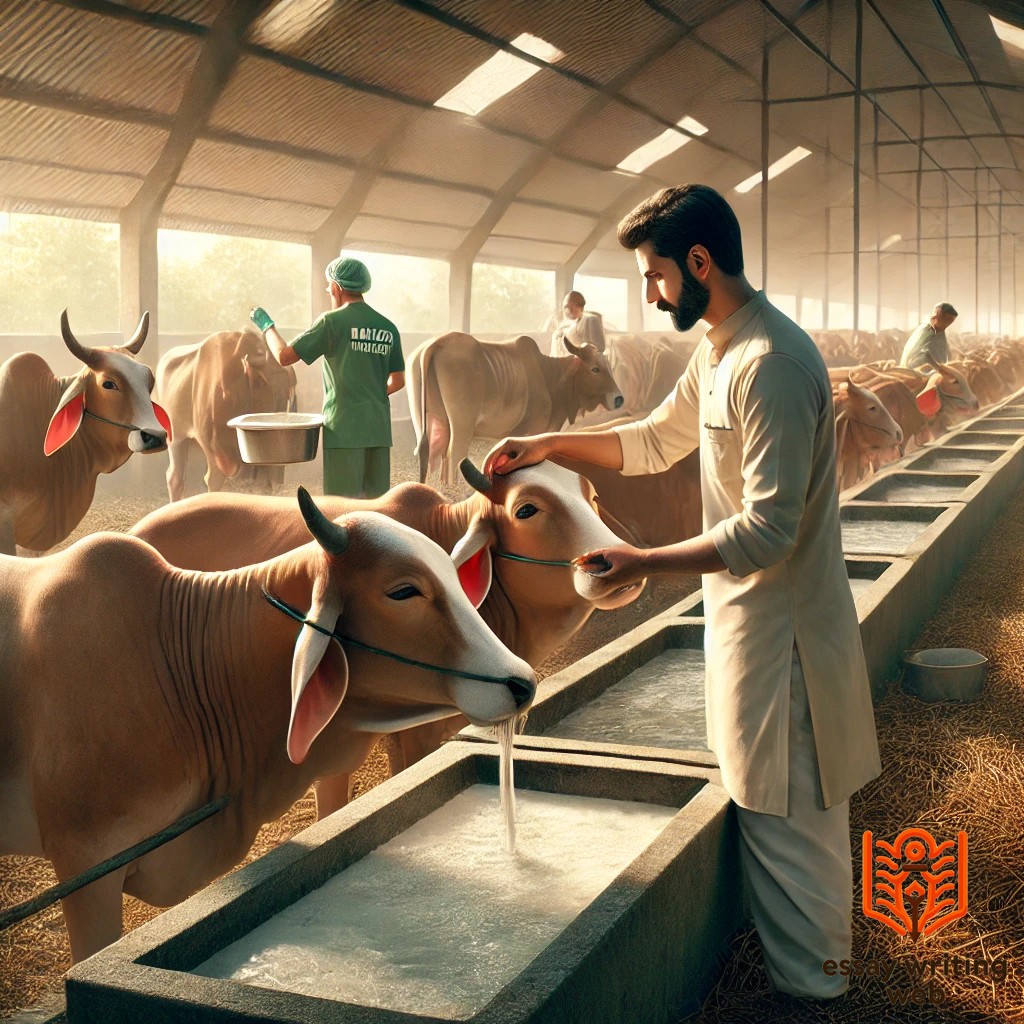 Essay Writing Web
Essay Writing Web
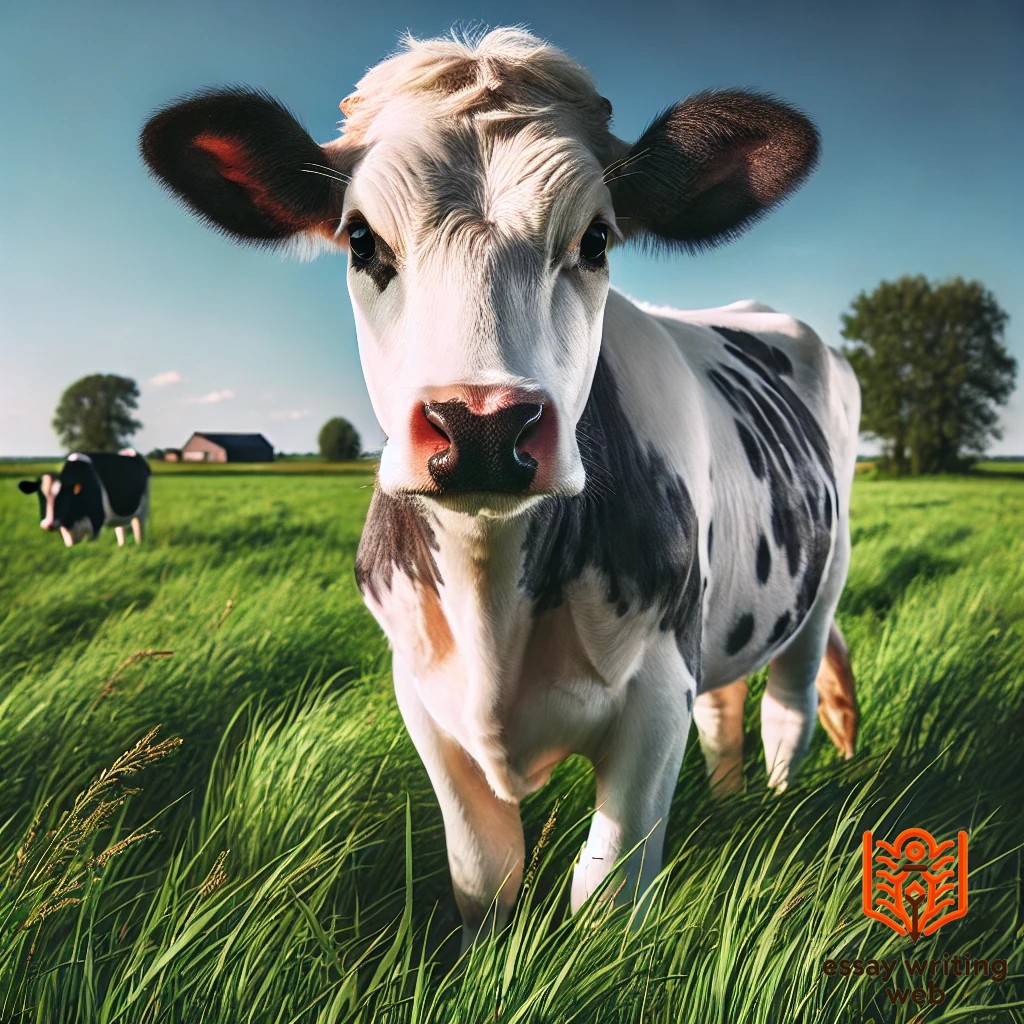
 18-09-2024
18-09-2024
 www.essaywritingweb.com
www.essaywritingweb.com
The cow is one of the most domesticated and revered animals across many parts of the world. Known for its gentle and calm nature, the cow has played a significant role in human civilization, especially in agriculture and dairy production. Throughout history, cows have been highly valued not only for their ability to provide essential resources such as milk, manure, and leather but also for their cultural and religious significance in various societies.
In many countries, particularly India, the cow holds a sacred position. It is often associated with nourishment and motherhood, symbolizing fertility and abundance. The milk provided by cows is a staple food item for many, used to produce dairy products like butter, cheese, and yogurt, which are integral to numerous diets around the globe. Beyond providing nourishment, cow dung has also been utilized for generations as a natural fertilizer, helping to sustain agricultural practices, especially in rural areas.
Cows are gentle herbivores and spend most of their day grazing on grass, converting this into energy and milk, making them essential for sustainable agriculture. In traditional societies, cows have been employed in farming for plowing fields and other tasks, further cementing their importance in rural livelihoods.
The cultural reverence for cows is evident in religious texts and practices, particularly in Hinduism, where the cow is considered sacred and often referred to as "Gaumata," meaning mother cow. This belief system has led to efforts toward cow protection and care, with various laws and organizations dedicated to their welfare.
Overall, the cow is a symbol of sustenance, cultural heritage, and environmental sustainability. Its contributions to human life, both materially and spiritually, make it a vital animal in many parts of the world.
The cow is a large, four-legged herbivorous mammal that belongs to the family Bovidae and the genus Bos. Known for its sturdy and robust build, a cow typically has a broad body with a long tail that ends in a tuft of hair. This tail helps the cow swat away flies and insects. The body of a cow is covered in a smooth coat of hair, which can vary in color depending on the breed. Common coat colors include white, brown, black, or a combination of these, with some cows displaying patches of different shades.
A cow’s head is characterized by a broad, flat nose and large, expressive eyes. Its ears are positioned on either side of its head and are often quite mobile, allowing the cow to detect sounds from its surroundings. Cows also possess horns, although the size and presence of these can vary depending on the breed, as some cows have been selectively bred to be hornless.
Cows are known for their strong, muscular legs, which are well-suited for supporting their large body mass. Their hooves are split into two parts, making them cloven-hoofed animals. The udders, located beneath the cow's belly, are one of the most distinctive features of female cows. These udders contain teats through which milk is produced and extracted.
Overall, the cow’s physical characteristics are well-adapted for grazing, farming, and dairy production, making it one of the most important domesticated animals in human society.
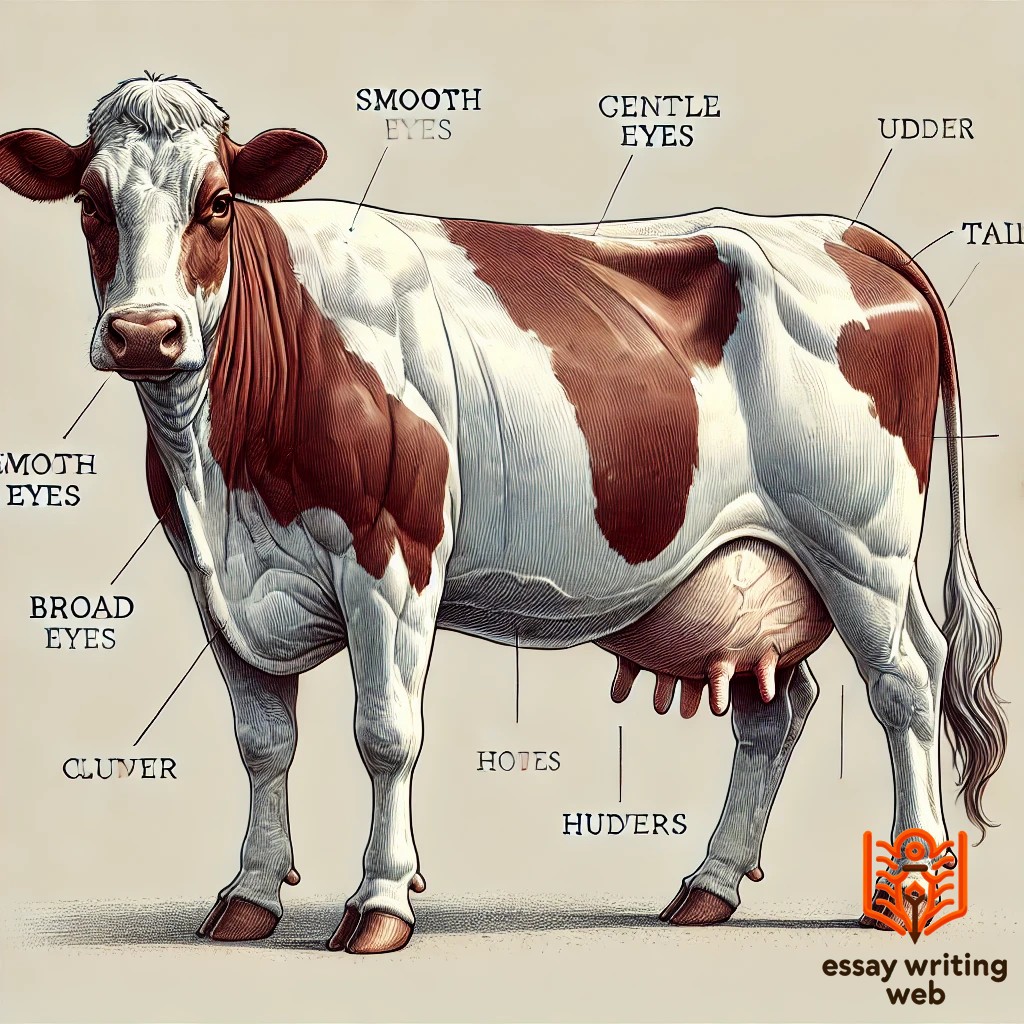
Cows, being one of the most domesticated animals in the world, come in a variety of breeds, each with its unique characteristics. These breeds are generally categorized based on their purpose—whether they are raised for dairy, beef, or dual-purpose (both milk and meat). Here are some of the most common types of cows.
Dairy cows are specifically bred for milk production and are known for their high milk yield. The most famous breed of dairy cow is the Holstein, which is easily recognizable by its black and white patches. Holsteins are the highest milk producers in the world. Another well-known dairy breed is the Jersey, smaller in size but known for producing milk rich in butterfat, making it ideal for butter and cheese production. Guernsey and Ayrshire are other popular dairy breeds that are valued for their milk quality.
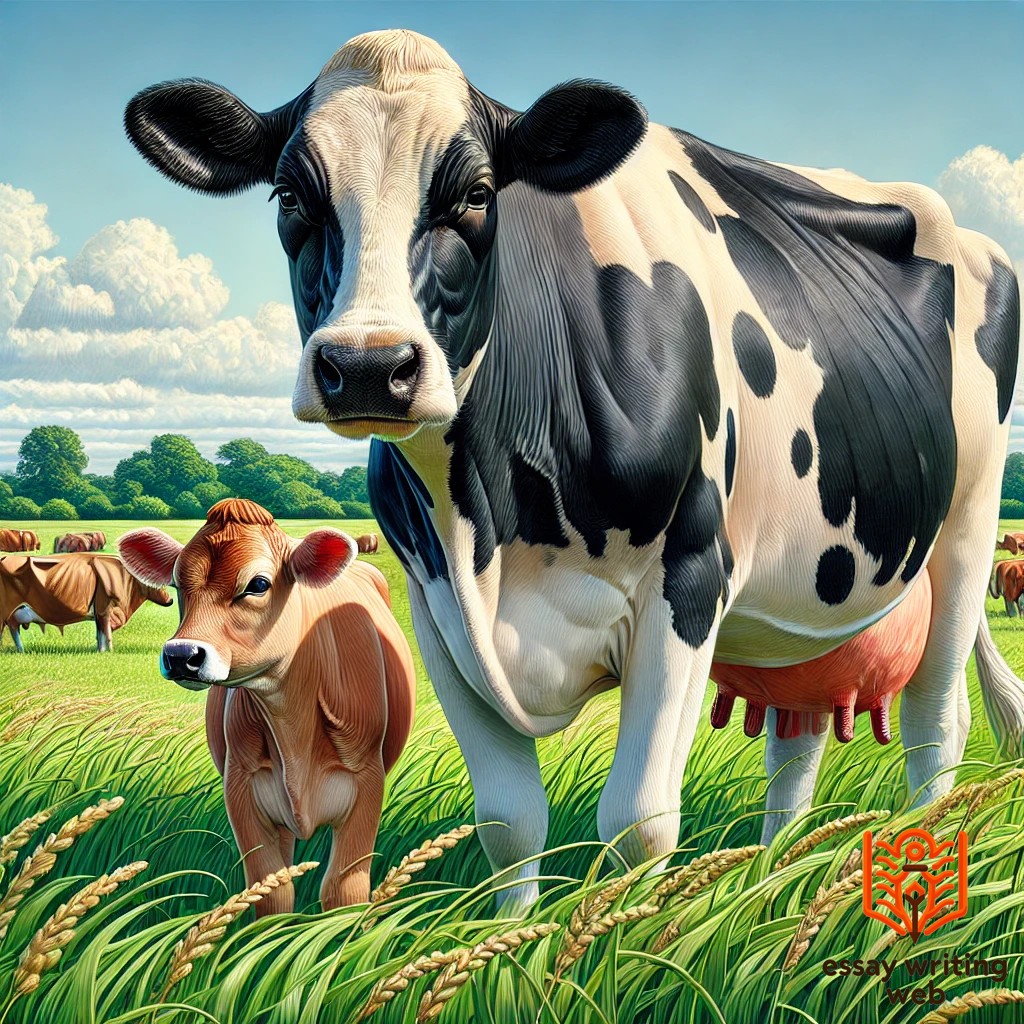
Some breeds serve both as dairy and beef producers. The Simmental breed, originally from Switzerland, is widely used for both milk and meat. The Brown Swiss is another dual-purpose breed, providing both a good quantity of milk and high-quality beef.
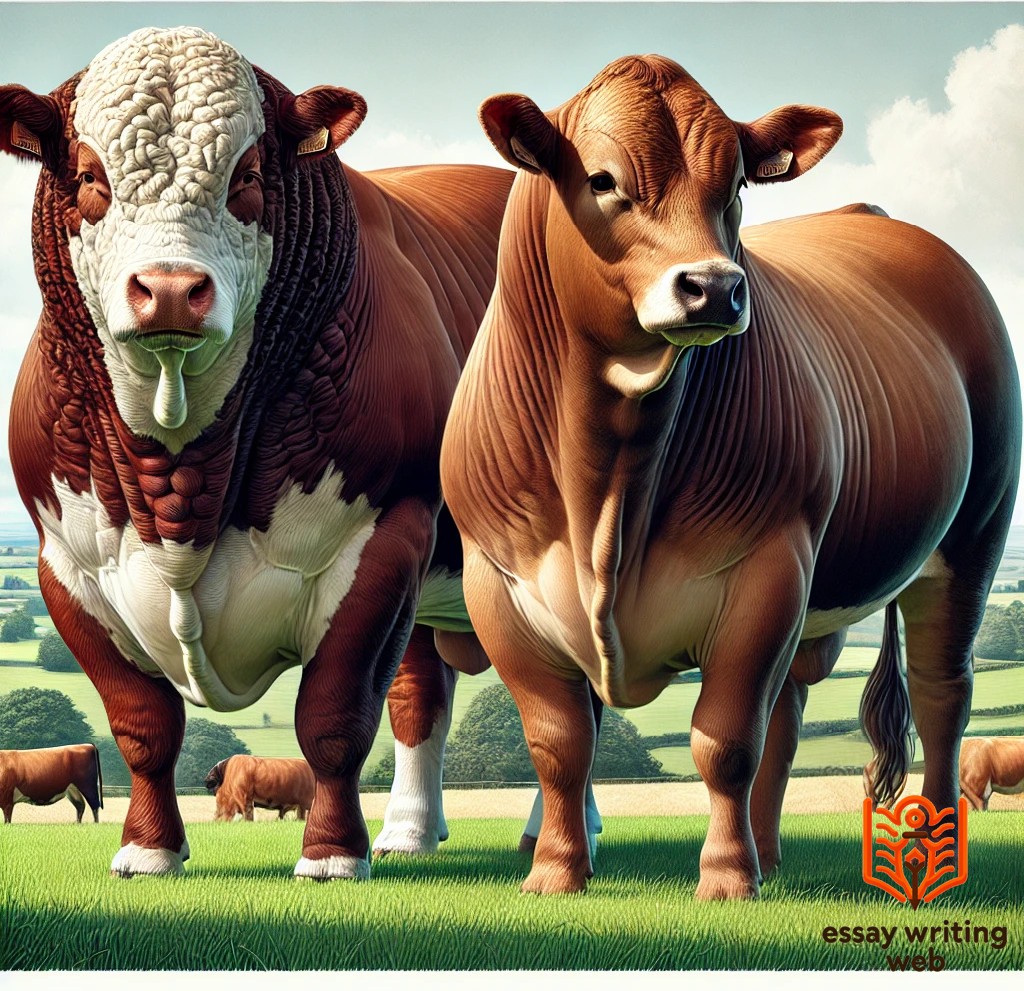
In many countries, particularly in India, there are indigenous breeds of cows that are valued not only for their milk and meat but also for their adaptability to local conditions. Gir, Sahiwal, and Red Sindhi are well-known Indian breeds that are hardy and capable of surviving in hot climates. They also have religious and cultural significance.
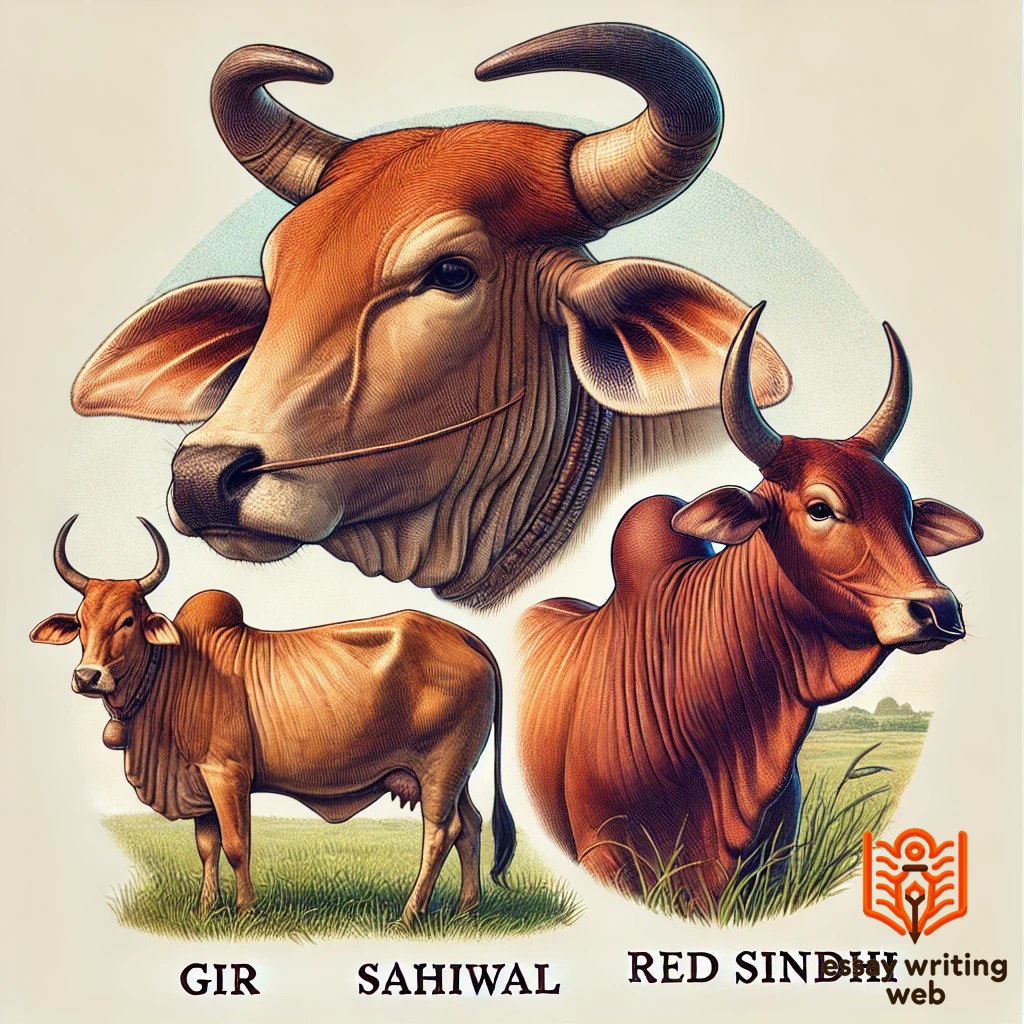
In conclusion, cows come in many types, each suited to specific purposes like milk, meat, or a combination of both. Whether dairy or beef, these breeds contribute significantly to human agriculture and livelihood, and their diversity allows for sustainable farming practices across the world.
Cows have been an integral part of agriculture for centuries, serving various essential roles in farming. In many rural and agricultural communities, cows are primarily valued for their ability to produce milk, which forms the basis of the dairy industry. Milk from cows is used to make numerous products like cheese, butter, and yogurt, making cows a cornerstone of dairy farming.
In addition to their role in dairy production, cows play a significant part in sustainable farming. Cow manure is a natural and effective fertilizer that enriches the soil, enhancing crop yields without the need for chemical fertilizers. This manure also serves as a fuel source when dried, especially in rural areas where alternative energy sources are scarce.
Historically, cows have been used as draught animals, pulling plows and carts to help in agricultural tasks. Though modern machinery has largely replaced cows in this role, in many parts of the world, especially in developing countries, cows still serve as an important labor force in farming.
Cows contribute to a sustainable agricultural cycle, providing milk, manure, and labor. Their importance to farming communities across the globe highlights their role as one of the most valuable domesticated animals in agriculture.

Cows play a crucial role in rural areas, providing vital resources for agricultural and domestic purposes. One of the most significant contributions of cows is milk production. Rural families rely on cow’s milk as a primary source of nutrition, which is rich in proteins and essential vitamins. Beyond daily consumption, milk is also used to produce dairy products like butter, ghee, cheese, and yogurt, which are staples in many rural households and markets.
Cows also provide manure, an invaluable resource for farming. Cow dung is used as an organic fertilizer, enriching soil fertility and enhancing crop yields without the use of harmful chemicals. The manure helps maintain the balance of nutrients in the soil, promoting sustainable farming practices. Additionally, dried cow dung serves as an affordable and accessible fuel source for cooking in many rural homes.
In traditional agricultural practices, cows are used for plowing fields. Especially in regions where modern machinery is either unavailable or unaffordable, cows help farmers prepare the soil for planting, ensuring a successful harvest season.
In summary, cows are essential in rural areas not just for their products but also for their labor, making them integral to both agricultural sustainability and rural livelihoods.
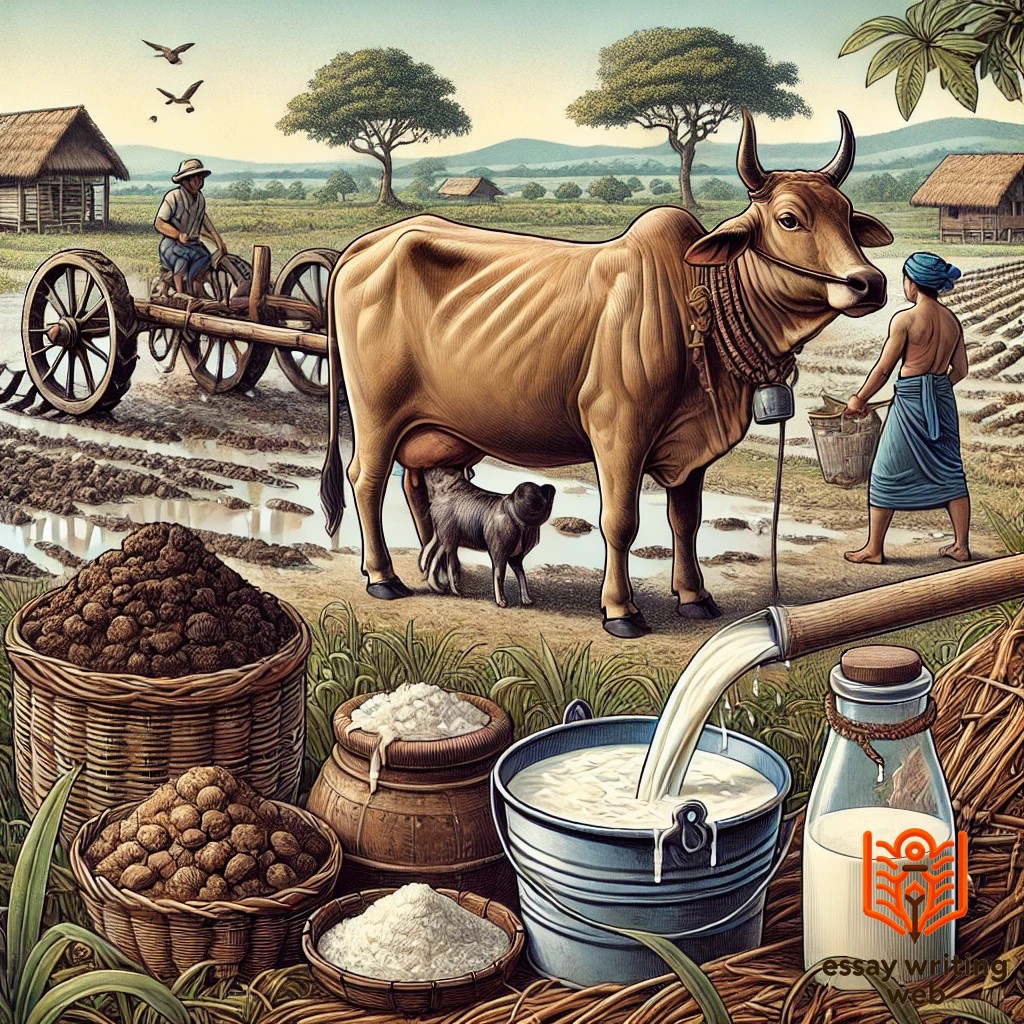
The cow holds deep cultural and religious significance in many parts of the world, especially in India. Revered as a symbol of purity, motherhood, and life-giving sustenance, cows are often associated with divinity in various religious traditions. In Hinduism, the cow is considered sacred and is referred to as "Gaumata," meaning mother cow. The cow’s ability to provide milk, a nourishing substance that supports life, makes it a symbol of fertility and selfless giving.
Hindu scriptures like the Vedas and Puranas frequently mention the cow as an embodiment of non-violence and abundance. In many Hindu rituals, offerings of milk, ghee, and other cow products are used in religious ceremonies, symbolizing purity and devotion. The festival of Gopashtami is dedicated to honoring cows, where people worship them as symbols of prosperity.
In addition to Hinduism, other religions such as Buddhism and Jainism also regard the cow with respect, often advocating for the protection of all living beings, including cows. Jainism, in particular, promotes non-violence (ahimsa), which extends to protecting cows and other animals.
Cows are also culturally significant in rural societies, where they symbolize wealth and prosperity. In many farming communities, the number of cows a family owns is often seen as a measure of their economic stability.
Overall, the cow’s cultural and religious significance transcends its physical contributions to human society, making it a revered and respected animal in various spiritual and cultural traditions around the world.
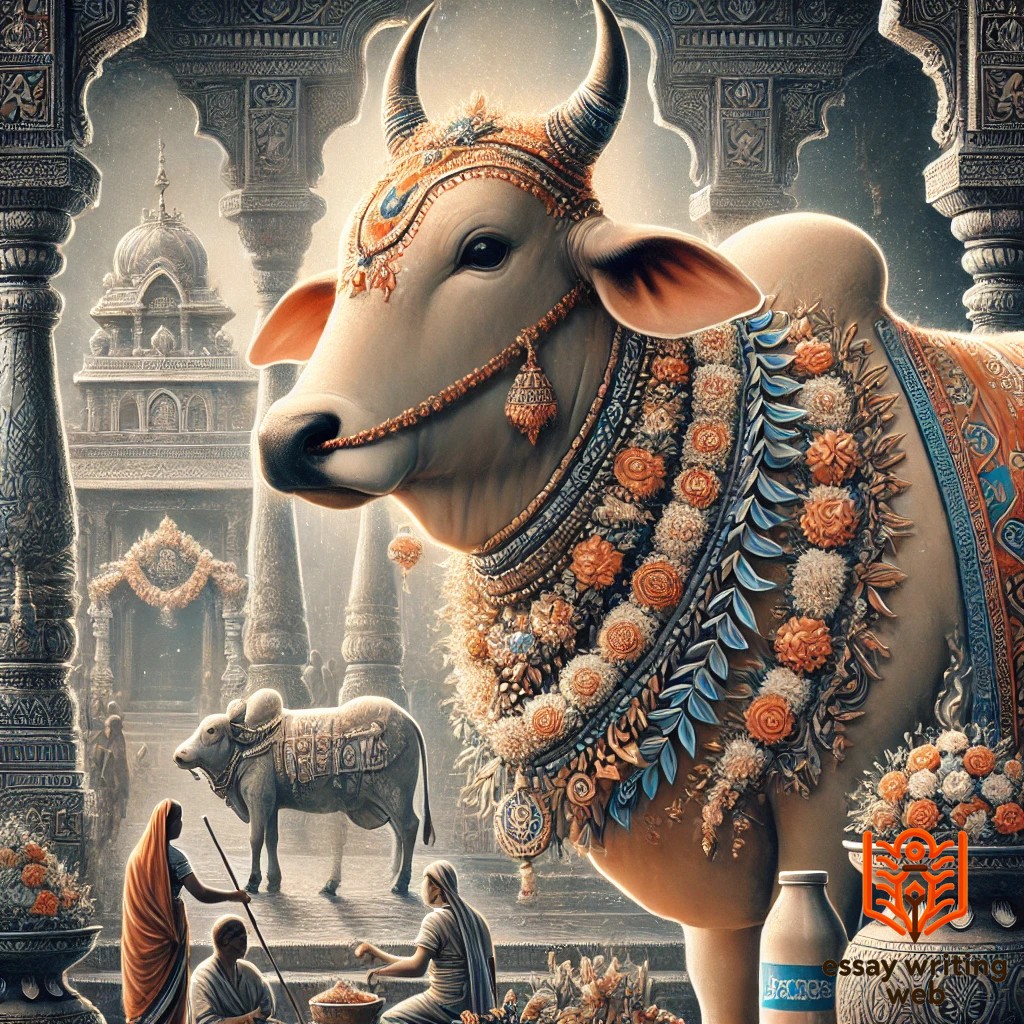
The cow plays a vital role in the global economy, particularly in rural and agricultural communities. One of the most important contributions of cows is their role in the dairy industry. Milk and dairy products such as cheese, butter, yogurt, and ghee are essential commodities that provide nutrition and serve as a source of income for millions of farmers. The dairy sector is a major contributor to the economy in many countries, generating employment and livelihood for both small-scale and large-scale dairy farmers.
Apart from dairy, cows are also economically valuable in terms of meat production. In many parts of the world, beef is a staple protein source, and the cattle industry supports a large portion of the food supply chain. Cows provide hides for leather production, another significant industry that creates jobs in manufacturing and exports.
In addition to direct products, cows offer by-products like manure, which is used as a natural fertilizer in farming. This organic fertilizer helps in maintaining soil fertility, reducing the need for expensive chemical fertilizers, and promoting sustainable agriculture. Cow dung is also used as an energy source in rural areas, providing an affordable alternative for fuel.
Cows are central to rural economies, not only for their direct products like milk, meat, and leather but also for their contributions to sustainable farming practices and employment generation. Their economic importance extends across various sectors, making them an indispensable asset in agricultural economies worldwide.
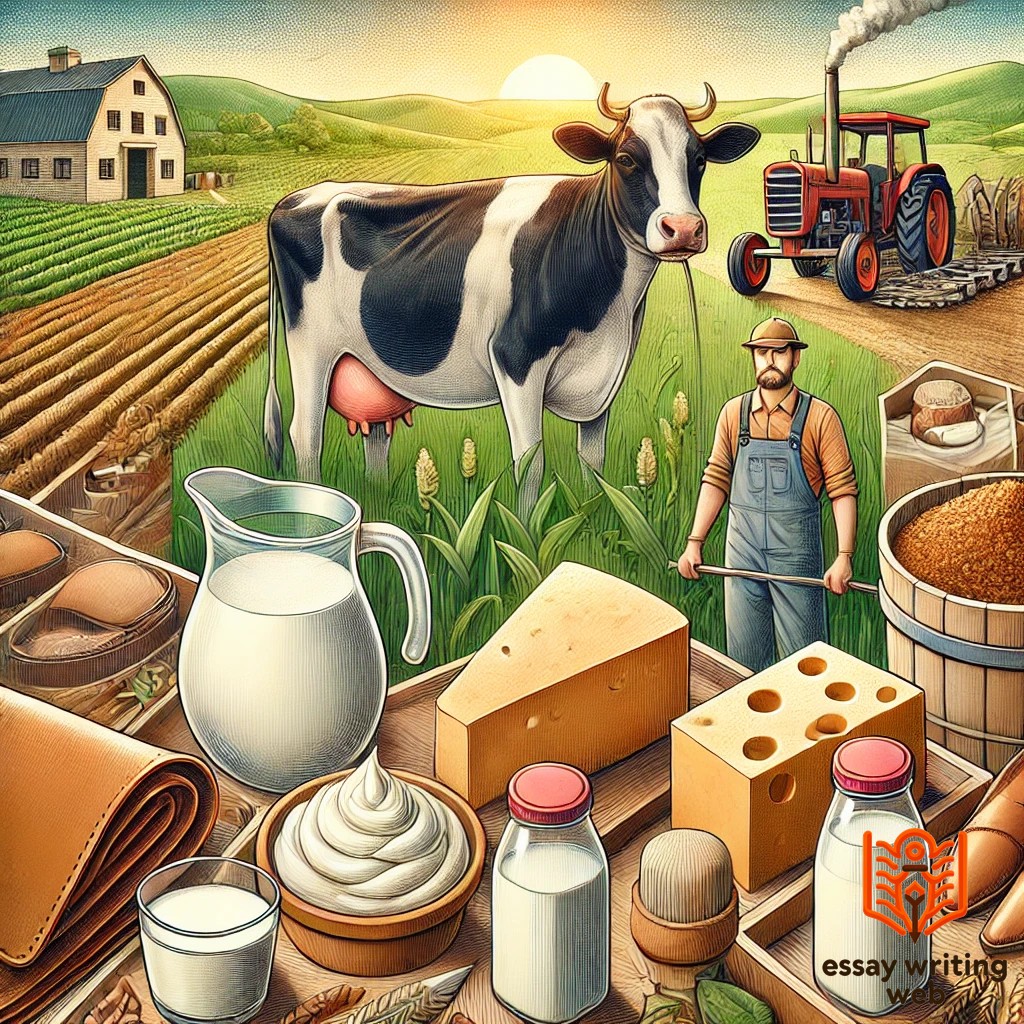
Cows contribute significantly to the environment, particularly in rural and agricultural settings, through their role in sustainable farming practices. One of the most notable contributions is the production of cow manure, which serves as an organic fertilizer. Manure enriches the soil by providing essential nutrients such as nitrogen, phosphorus, and potassium, promoting healthy crop growth without relying on synthetic fertilizers. This natural method of soil enrichment supports sustainable agriculture, improving the quality of crops and reducing the environmental impact of chemical use.
Moreover, cow dung has been traditionally used as a renewable energy source. In rural areas, dried cow dung is used as fuel for cooking and heating, reducing the dependence on wood and fossil fuels. This practice not only provides an affordable energy source but also helps in preserving forests and reducing carbon emissions.
Cows also play a role in reducing food waste. They can consume crop residues, turning otherwise discarded agricultural by-products into valuable resources like milk and manure.
In addition to their direct environmental benefits, cows contribute to biodiversity in farming systems. By grazing, they help maintain pastures and prevent overgrowth, which supports a diverse range of plant species and wildlife.
Overall, cows are essential to eco-friendly farming and rural sustainability, contributing to environmental conservation and resource efficiency.

The protection and care of cows have been a priority in many cultures, particularly in regions where cows are revered for their religious and economic significance. In India, the protection of cows is deeply rooted in tradition, with laws in place to prevent their slaughter and ensure their well-being. Numerous shelters, known as gaushalas, are established to care for abandoned or aging cows, providing them with food, shelter, and medical attention.
Caring for cows requires attention to their nutritional, health, and environmental needs. A balanced diet is essential for maintaining the health of cows, especially in dairy farming, where nutrition directly impacts milk production. Access to clean water, proper shelter, and regular veterinary care are also critical for ensuring their well-being.
Animal rights organizations around the world advocate for ethical treatment of cows, highlighting the importance of humane farming practices and proper care. Overworking, lack of proper shelter, and inadequate nutrition can lead to health problems, reducing the quality of life for cows.
In addition to legal measures and animal welfare groups, individual farmers play a vital role in protecting cows by ensuring they live in a clean, safe environment. The protection and proper care of cows are essential for their well-being and for sustaining their economic contributions to society.
